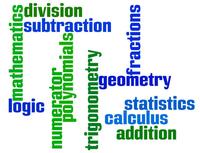Kindergarten Mathematics Topics and Sub-topics

NUMBER SENSE KINDERGARTEN
1. Say the number sequence 1 to 10 by 1s, starting anywhere from 1 to 10 and from 10 to 1.
2. Subitize (recognize at a glance) and name familiar arrangements of 1 to 5 objects or dots.
3. Relate a numeral, 1 to 10, to its respective quantity.
4. Represent and describe numbers 2 to 10, concretely and pictorially.
5. Compare quantities 1 to 10, using one-to-one correspondence.
PATTERNS AND RELATIONS
Patterns • Use patterns to describe the world and to solve problems.
Variables and Equations • Represent algebraic expressions in multiple ways.
SHAPE AND SPACE
Measurement • Use direct and indirect measurement to solve problems.
3-D Objects and 2-D Shapes
• Describe the characteristics of 3-D objects and 2-D shapes, and analyze the relationships among them.
Transformations
• Describe and analyze position and motion of objects and shapes.
STATISTICS AND PROBABILITY
Data Analysis • Collect, display and analyze data to solve problems.
Chance and Uncertainty • Use experimental or theoretical probabilities to represent and solve problems involving uncertainty.
Number Sense
• Patterns
• Patterns
• Patterns
• Patterns
Patterns and Relations
• Patterns
• Variables and Equations
• Patterns
• Patterns
• Patterns
Shape and Space
• Measurement
• 3-D Objects and 2-D Shapes
• Transformations
• Patterns
• Patterns
Statistics and Probability
• Data Analysis
• Chance and Uncertainty
• Patterns
• Patterns
• Patterns
1. Say the number sequence 1 to 10 by 1s, starting anywhere from 1 to 10 and from 10 to 1.
2. Subitize (recognize at a glance) and name familiar arrangements of 1 to 5 objects or dots.
3. Relate a numeral, 1 to 10, to its respective quantity.
4. Represent and describe numbers 2 to 10, concretely and pictorially.
5. Compare quantities 1 to 10, using one-to-one correspondence.
PATTERNS AND RELATIONS
Patterns • Use patterns to describe the world and to solve problems.
Variables and Equations • Represent algebraic expressions in multiple ways.
SHAPE AND SPACE
Measurement • Use direct and indirect measurement to solve problems.
3-D Objects and 2-D Shapes
• Describe the characteristics of 3-D objects and 2-D shapes, and analyze the relationships among them.
Transformations
• Describe and analyze position and motion of objects and shapes.
STATISTICS AND PROBABILITY
Data Analysis • Collect, display and analyze data to solve problems.
Chance and Uncertainty • Use experimental or theoretical probabilities to represent and solve problems involving uncertainty.
Number Sense
• Patterns
• Patterns
• Patterns
• Patterns
Patterns and Relations
• Patterns
• Variables and Equations
• Patterns
• Patterns
• Patterns
Shape and Space
• Measurement
• 3-D Objects and 2-D Shapes
• Transformations
• Patterns
• Patterns
Statistics and Probability
• Data Analysis
• Chance and Uncertainty
• Patterns
• Patterns
• Patterns
